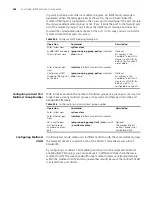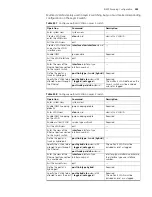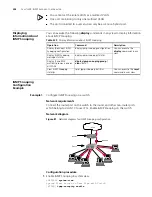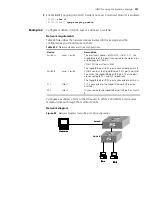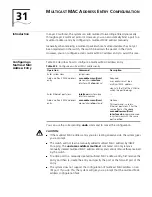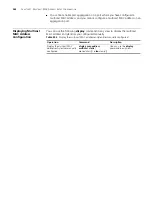
268
C
HAPTER
32: C
LUSTER
C
ONFIGURATION
Upon detecting a change occurred on a neighbor, a member device informs the
management device of the change through handshake packets. The management
device then collects the specified topology information through NTDP. Such a
mechanism enables topology changes to be tracked in time.
As for NTDP implementing, you need to perform configurations on the management
device, the member devices, and the candidate devices as follows:
On the management device, enable NTDP both globally and for specific ports, and
configure the NTDP settings.
On each member device and candidate device, enable NTDP both globally and for
specific ports. As member devices and candidate devices adopt the NTDP settings
configured for the management device, NTDP setting configurations are not needed.
Introduction to Cluster
Roles
A cluster has one (and only one) management device. Note the following when
creating a cluster:
■
You need to designate the management device first. The management device of a
cluster is the portal of the cluster. That is, any operations performed in external
networks and intended for the member devices of a cluster, such as accessing,
configuring, managing, and monitoring, can only be implemented through the
management device.
■
The management device of a cluster recognizes and controls all the member
devices in the cluster, no matter where they are located on the network or how
they are connected.
■
The management device collects topology information about all the member and
candidate devices to provide useful information for users to establish a cluster.
■
A management device manages and monitors the devices in the cluster by
collecting and processing NDP/NTDP packets. NDP/NTDP packets contain network
topology information.
All the above-mentioned operations need the support of the cluster function.
You need to enable the cluster function and configure cluster parameters on a
management device. However, you only need to enable the cluster function on the
member devices and candidate devices.
You can also configure an FTP/TFTP server for a cluster on the management device. In
this case, the communications between a member device in the cluster and an
external server are carried out by the management device. For clusters with no
FTP/TFTP server configured, the management device operates as the public FTP/TFTP
server.
Management Device
Configuration
Management device configuration involves:
■
Enabling NDP globally and for specific ports
■
Configuring NDP-related parameters
■
Enable NTDP globally and for a specific port
■
Configuring NTDP-related parameters
■
Enable the cluster function
■
Configuring cluster parameters
■
Configuring internal-external interaction
Summary of Contents for 4200G 12-Port
Page 10: ...8 CONTENTS...
Page 14: ...4 ABOUT THIS GUIDE...
Page 46: ...32 CHAPTER 5 LOGGING IN THROUGH WEB BASED NETWORK MANAGEMENT SYSTEM...
Page 48: ...34 CHAPTER 6 LOGGING IN THROUGH NMS...
Page 60: ...46 CHAPTER 9 VLAN CONFIGURATION...
Page 64: ...50 CHAPTER 10 MANAGEMENT VLAN CONFIGURATION...
Page 80: ...66 CHAPTER 13 GVRP CONFIGURATION...
Page 98: ...84 CHAPTER 15 LINK AGGREGATION CONFIGURATION...
Page 112: ...98 CHAPTER 18 MAC ADDRESS TABLE MANAGEMENT...
Page 126: ...112 CHAPTER 19 LOGGING IN THROUGH TELNET...
Page 162: ...148 CHAPTER 20 MSTP CONFIGURATION...
Page 274: ...260 CHAPTER 29 IGMP SNOOPING CONFIGURATION...
Page 276: ...262 CHAPTER 30 ROUTING PORT JOIN TO MULTICAST GROUP CONFIGURATION...
Page 298: ...284 CHAPTER 33 SNMP CONFIGURATION...
Page 304: ...290 CHAPTER 34 RMON CONFIGURATION...
Page 338: ...324 CHAPTER 36 SSH TERMINAL SERVICES...
Page 356: ...342 CHAPTER 38 FTP AND TFTP CONFIGURATION...
Page 365: ...Information Center Configuration Example 351 S4200G terminal logging...
Page 366: ...352 CHAPTER 39 INFORMATION CENTER...
Page 378: ...364 CHAPTER 40 BOOTROM AND HOST SOFTWARE LOADING...
Page 384: ...370 CHAPTER 41 Basic System Configuration and Debugging...
Page 388: ...374 CHAPTER 43 NETWORK CONNECTIVITY TEST...
Page 406: ...392 CHAPTER 45 CONFIGURATION OF NEWLY ADDED CLUSTER FUNCTIONS...

